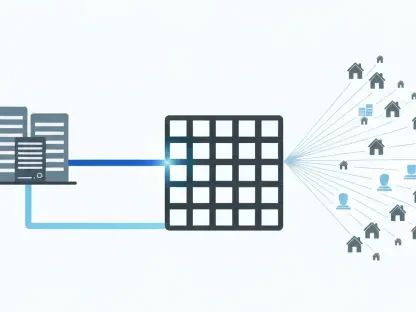In today’s fast-paced business environment, data has rapidly become a company’s most precious asset. It’s no longer effective to just collect vast amounts of data and perform retrospective analysis. Businesses must act on this data in real-time to deliver impactful customer experiences, adapt quickly to changing market conditions, and seize revenue opportunities as they arise. Achieving this level of agility involves effectively managing real-time data streams, which is a challenging feat due to common obstacles such as data silos. These silos can prevent IT departments from delivering the right data to the right business units promptly. To navigate these challenges successfully, organizations must accelerate their data integration performance using strategic frameworks like event-driven architectures (EDAs).
1. Employ Event-Driven Architectures
Event-driven architectures are crucial for managing real-time data as they react to immediate changes or states of an entity, letting applications respond at the “speed of business.” By freeing transactions from sequential processing and enabling parallel work across multiple queues, EDAs offer greater scalability and flexibility. Businesses can utilize EDAs to support real-time business events, facilitating bidirectional communication between applications and data stores. This architectural approach addresses the limitations of traditional batched data processing, aligning more effectively with the immediate needs in consumer-facing interactions and business operations.
By employing an EDA, companies can dismantle the barriers set by data silos while facilitating seamless data flow across departments. This architecture empowers businesses to deliver personalized customer experiences in real-time. A prime example includes scenarios where customers interacting with a brand’s online services should not have to repeatedly provide their identification details if already signed in. This illustrates the necessity for an interconnected IT landscape where systems are fluidly integrated, and data is available instantly. Companies that achieve this level of integration can meet the evolving expectations of their customers, ultimately staying ahead of the competition.
2. Seamlessly Integrate Data Sources and Applications
Seamless integration of data sources and applications is another critical step in overcoming real-time data integration challenges. Organizations need to leverage Integration Platform as a Service (iPaaS) solutions that facilitate the unification of various data formats and streamline effective data streaming and integration. iPaaS tools enable the connection of disparate systems, ensuring that data can flow seamlessly across platforms regardless of their original formats or origins. This results in the creation of a more consistent and comprehensive data ecosystem that supports real-time processing and analytics.
The integration of data sources becomes increasingly complex in larger organizations where different business units might have their own specific technologies and data stores. To address this, it’s essential to use iPaaS solutions recognized for their robustness and versatility, as highlighted in reports such as Gartner’s iPaaS Magic Quadrant. These solutions help companies break down the barriers between various data silos, ensuring that critical data is accessible, current, and reliable. By unifying the data landscape, businesses can enhance operational efficiency and provide more cohesive customer experiences, capitalizing on real-time data insights.
3. Invest in Real-Time Data Governance and Quality Assurance
Maintaining data quality and governance is essential for the successful integration of real-time data streams. Real-time data governance involves implementing robust protocols and automation tools to ensure the data’s consistency, completeness, and accuracy across the enterprise. This approach helps prevent data from being misdirected or misinterpreted and provides the right context for data utilization. Implementing workflow tools for filtering, contextualization, and integration tooling ensures that only high-quality, relevant data reaches the accurate endpoints during real-time processes.
Investing in real-time data governance also entails setting comprehensive data quality control measures that address the unique challenges posed by different data sources. Each data source may have different origins, governance requirements, and formats, complicating the task of maintaining uniform data quality. Automation plays a key role here, enabling the consistent enforcement of governance policies and reducing the manual workload involved in data management. By ensuring that high-quality data is available and reliable, businesses can derive more accurate insights and enhance their ability to react promptly to market changes.
4. Leverage Artificial Intelligence and Machine Learning
Artificial intelligence (AI) and machine learning (ML) have evolved significantly in recent years, becoming crucial tools for synthesizing data and enabling its broader, more effective use. By investing in AI and ML technologies, companies can break down data silos and derive real-time insights that can be used to personalize customer experiences. These technologies help organizations automate data analysis processes, uncover hidden patterns in data, and make predictive decisions based on real-time information, thereby enhancing the overall value derived from their data assets.
AI and ML are particularly effective in industries with vast amounts of unstructured data, such as healthcare, finance, and retail. For instance, AI-driven analytics can help healthcare providers predict patient needs and personalize treatment plans, while retailers can use ML algorithms to analyze consumer behavior and optimize inventory management. By leveraging AI and ML, businesses can not only improve the accuracy and speed of their data analyses but also drive innovation and growth through enhanced data-driven decision-making. Investing in these technologies positions organizations to meet modern demands for timely, relevant, and personalized customer interactions.
5. Enhance the Convergence of Applications and Analytics
The convergence of user-facing applications and analytics is a growing trend in enterprise IT, driven by the need to handle massive amounts of data in real-time. As big data technologies have advanced, businesses now possess the capabilities to process and analyze large volumes of data quickly and efficiently. The emergence of AI further accelerates this convergence, as its applications span both worlds, providing valuable insights that are immediately actionable within user-facing applications.
Traditionally, the analytics world has been batch-driven, managing data volumes over longer periods. However, the increasing need for real-time insights calls for redefining how data engineering views the enterprise. Instead of separating data sources and targets, the modern approach treats all parts of the enterprise as a collection of bidirectional data endpoints. This shift enables efficient communication and data flow across the organization, ensuring that real-time insights are seamlessly injected into applications and operational processes. By adopting this perspective, businesses can maximize the benefits of real-time data streams, enhancing operational agility and customer satisfaction.
Are You Ready to Deliver Real-Time Data Streams?
Seamless integration of data sources and applications is essential in overcoming real-time data integration challenges. Organizations must leverage Integration Platform as a Service (iPaaS) solutions that simplify the unification of various data formats and streamline data streaming and integration. iPaaS tools connect disparate systems, ensuring data flows seamlessly across platforms, regardless of their original formats or origins. This fosters a consistent and comprehensive data ecosystem supporting real-time processing and analytics.
The integration of data sources becomes increasingly complex in larger organizations where different business units might have their own technologies and data stores. To address this, it’s crucial to adopt iPaaS solutions recognized for their robustness and versatility, as highlighted in Gartner’s iPaaS Magic Quadrant. These solutions help companies dismantle data silos, ensuring critical data is accessible, current, and reliable. By unifying the data landscape, businesses can enhance operational efficiency and deliver more cohesive customer experiences, capitalizing on real-time data insights.









